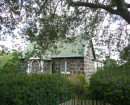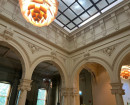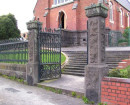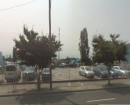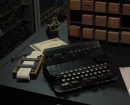Back to search results
City Oval Grandstand
1402-1406 STURT STREET, AND 1431, 1441, AND 1443 MAIR STREET, LAKE WENDOUREE - PROPERTY NUMBERS 2043469, 2021832, BALLARAT CITY
West Ballarat Precinct
City Oval Grandstand
1402-1406 STURT STREET, AND 1431, 1441, AND 1443 MAIR STREET, LAKE WENDOUREE - PROPERTY NUMBERS 2043469, 2021832, BALLARAT CITY
West Ballarat Precinct
All information on this page is maintained by Ballarat City.
Click below for their website and contact details.
Ballarat City
-
Add to tour
You must log in to do that.
-
Share
-
Shortlist place
You must log in to do that.
- Download report

City Oval Grandstand






On this page:
Statement of Significance
What is significant?
How is it significant?
Why is it significant?
Part of Recommended Area A3.7
No SoS provided in this citation. Please refer to the Attachments section in this place record for further information.
Show more
Show less
-
-
City Oval Grandstand - Physical Description 1
The City Oval Grandstand comprises a curved barrel vaulted roof carried on iron columns with a small section of cantilevered awning around the front and sides. The roof and cantilever are supported on particularly elegant (four to a column) deep brackets with a fifth at the two corners. There are three square pavilions On the roof with five louvered openings on each, separated by fluted pilasters with Concave roof rising to a smaller squat structure which supports the flagpole. There is a sunflower pattern, balustraded front, and the elevated tiers of seats are constructed on a brick base. The structure is basically intact, and is set among other buildings that contribute to this building's environment. This building ranks as one of the most elaborate surviving Victorian grand stands in the State. It represents the Victorian romantic penchant for follies, once quite common in recreational buildings.
City Oval Grandstand - Physical Description 2
The City Oval Grandstand comprises a curved barrel vaulted roof carried on iron columns with a small section of cantilevered awning around the front and sides going out another metre. This is supported on particularly elegant deep brackets curving down to the capitals of the columns with decorative spandrel discs. The brackets have four arms, except at the corner where they meet where there are five.
Perhaps the most remarkable features of this building are the three square pavilions with concave roofs rising to a smaller squat structure which supports the flagpole. Each side of the pavilion is divided into five louvered openings separated by fluted pilasters.
The front of the stand has balustrades consisting of broad panels of late cast iron in a sunflower pattern, and alternating with bars of wrought iron, possibly of a recent date.
The grand stand is basically intact, although some changes appear to have been made to the balustrading and to the ground floor fenestrations in the brick base structure. There are some structural problems in this section which require specialist engineering advice.
The surrounds of the grand stand are also of interest. Associated with the grand stand are twb wooden ticket boxes facing the gate, each with its own little arched roof. The arched eave being decorated with vertical boards with curved lower ends, forming a sort of valence with a small rectangular curved gable in each end.
The adjacent men's toilets are also of interest for their intact fittings and toilet doors.
The iron fencing is also compatible and there is space at the rear of the grand stand where development could be concealed. However, the Country Fire Authority track at the front of the grand stand is most intrusive. It isolates the grand stand from the sporting oval which jeopardises the building's usefulness. The asphalt paving, cyclone mesh fences and steel tower are out of character with this remarkable oval.
This building ranks as one of the most elaborate surviving Victorian grandstands in the State. Few of the major comparable structures, such as the pre-1955 Melbourne Cricket Ground, or Flemington Racecourse remain. The Victorian romantic penchant for follies was perhaps best expressed in recreational buildings. Unfortunately they were usually largely constructed of timber or have stood in the way of redevelopment plans,such as occurred because of the 1956 Olympic Games in Melbourne. Ballarat is fortunate to possess other important surviving passive recreational buildings - the Sturt Street band stands, the various buildings in the Botanical Gardens, and the two cemeteries. The City Oval Grandstand is, however, the most imposing as well as being of major architectural interest, specifically because of the roof and its supporting structure, and the pavilions.Heritage Study and Grading
Ballarat - Ballarat Heritage Precincts Study
Author: Dr David Rowe and Wendy Jacobs
Year: 2006
Grading:
-
-
-
-
-
BISHOPS PALACE
 Victorian Heritage Register H0413
Victorian Heritage Register H0413 -
LAKE WENDOUREE
 Victorian Heritage Register H2419
Victorian Heritage Register H2419 -
WEST NEWINGTON GOLD MINING SITE
 Victorian Heritage Inventory
Victorian Heritage Inventory
-
"1890"
 Yarra City
Yarra City -
"AMF Officers" Shed
 Moorabool Shire
Moorabool Shire -
"AQUA PROFONDA" SIGN, FITZROY POOL
 Victorian Heritage Register H1687
Victorian Heritage Register H1687
-
13 Flinders Street, Queenscliff
 Queenscliffe Borough
Queenscliffe Borough -
162 Nicholson Street
 Yarra City
Yarra City -
164 Nicholson Street
 Yarra City
Yarra City
-
-








